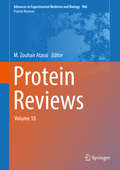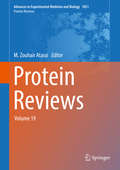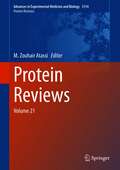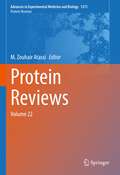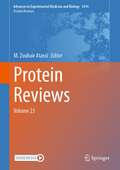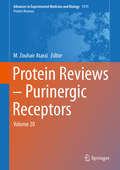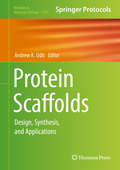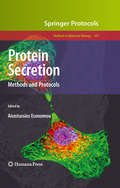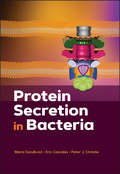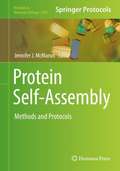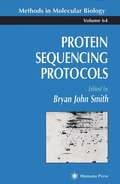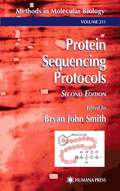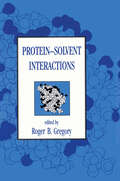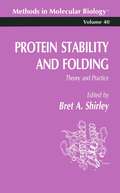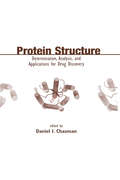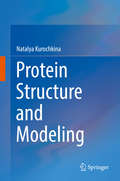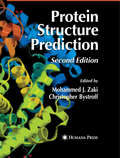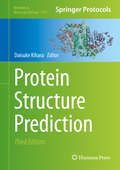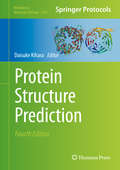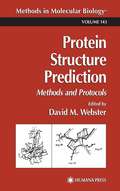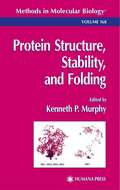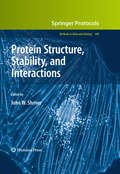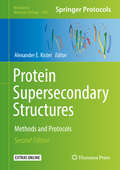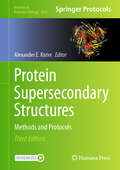- Table View
- List View
Protein Reviews
by M. Zouhair AtassiThe aim of the Protein Reviews is to serve as a publication vehicle for review articles that focus on crucial current vigorous aspects of protein structure, function, evolution and genetics. Volume 17 of Protein Reviews is the beginning of a new publication format. The volumes will appear online before they are published in a printed book. Articles will be selected according to their importance to the understanding of biological systems, their relevance to the unravelling of issues associated with health and disease or their impact on scientific or technological advances and developments. The chapters in this volume are authored by experts in the field. They deal with aspects of structure and biological activity of selected proteins. Specific chapters deal with the aggregation of FET proteins (FUS, EWSR1, TAF15) as a pathological change in amyotrophic lateral sclerosis, structural changes fundamental to gating of the cystic fibrosis transmembrane conductance regulator anion channel pore, the dual roles for epithelial splicing regulatory proteins 1 (ESRP1) and 2 (ESRP2) in cancer progression, controlling autolysis during flagella insertion in Gram-negative bacteria, the regulation of skeletal muscle myoblast differentiation and the proliferation by pannexins, hyaluronidase and chondroitinase, factors that control mitotic spindle elongation, how secreted phospholipase A2 type IIA (sPLA2-IIA) activates integrins in an allosteric manner, the simple and unique allosteric machinery of Thermus caldophilus lactate dehydrogenase, and the reduction of chemically stable multibonds: Nitrogenase-like biosynthesis of tetrapyrroles. This volume is intended for research scientists, clinicians, physicians, and graduate students in fields of biochemistry, cell biology, molecular biology microbiology, immunology and genetics.
Protein Reviews
by M. Zouhair AtassiThe aim of the Protein Reviews is to serve as a publication vehicle for review articles that focus on crucial current vigorous aspects of protein structure, function, evolution and genetics. The volumes will appear online before they are published in a printed book. Articles are selected according to their importance to the understanding of biological systems, their relevance to the unravelling of issues associated with health and disease or their impact on scientific or technological advances and developments. The chapters in volume 18 are authored by experts in the field. They deal with aspects of structure and/or biological activity of selected proteins. The chapters review current research of the following topics: the Mechanism of channel gating and regulation of the activity of calcium-activated chloride channel ANO1, Structure and function of the two-component cytotoxins of Staphylococcus aureus, Membrane Fusion and Infection involving the influenza virus hemagglutinin, The impact of arrhythmogenic mutations through the structural determination of the L-type voltage-gated calcium channel, Discussion of some open questions pertaining to histone post-translational modifications and nucleosome organization in transcriptional regulation, Regulation of the extracellular SERPINA5 (protein C inhibitor) penetration through cellular membranes, Coding of Class I and II aminoacyl-tRNA synthetases, Nephrin phosphorylation in diabetes and chronic kidney injury, The structure-forming juncture in oxidative protein folding and the events in the ER, The polyspecificity of anti-lipid antibodies and its relevance to the development of autoimmunity. This volume is intended for research scientists, clinicians, physicians and graduate students in the fields of biochemistry, cell biology, molecular biology, immunology and genetics.
Protein Reviews: Volume 21 (Advances in Experimental Medicine and Biology #21)
by M. Zouhair AtassiThe Protein Reviews series serves as a publication vehicle for reviews that focus on crucial contemporary and vital aspects of protein structure, function, evolution and genetics. Volumes are published online first, prior to publication in a printed book. Chapters are selected according to their importance to the understanding of biological systems, relevance to the unravelling of issues associated with health and disease, or impact on scientific or technological advances and developments. Volume 21 presents eight review chapters authored by experts in the related fields. The first chapter covers the enzyme squalene monooxygenase and lipid levels and its relevance in health and disease. Chapter two presents a systematic analysis of the structural and functional aspects of heteromeric solute carriers. The third chapter provides a review of the role of CI- in type IV collagen assembly, function, and disease, including future directions for studies. This is followed by a summary in chapter four about the recent progress on defining the roles of the Slit-Robo signaling in bone metabolism and the possible roles of the interaction between Robo and neural epidermal growth factor-like proteins. Chapter five discusses recent data about the evolutionary aspects on structural differences between humans and the nematode in relation to previous knowledge of core proteins and GAG-attachment sites in Chn and CS proteoglycans of C.elegans and humans. The sixth chapter summarizes the immunochemical character of the IGHV1-69-derived RFs and the recognition mechanism of the IGHV1-69-derived RFs. Chapter seven covers regulated alternative translocation and its role as an emerging mechanism to regulate transmembrane proteins. Finally, chapter eight reviews current progress on IL-36 protein and biology and novel investigative tools. This volume is intended for research scientists, clinicians, physicians and graduate students in the fields of biochemistry, cell biology, molecular biology, immunology and genetics.
Protein Reviews: Volume 22 (Advances in Experimental Medicine and Biology #1371)
by M. Zouhair AtassiThe Protein Reviews series serves as a publication vehicle for reviews that focus on crucial contemporary and vital aspects of protein structure, function, evolution and genetics. Volumes are published online first, prior to publication in a printed book. Chapters are selected according to their importance to the understanding of biological systems, relevance to the unravelling of issues associated with health and disease, or impact on scientific or technological advances and developments. Volume 22 presents six review chapters authored by experts in related fields. The first chapter covers carotenoid-protein interactions. Chapter two addresses the non-continuum of eukaryotic transcriptional regulation. The third chapter reviews the structure of the regulatory and catalytic domains of the photoreceptor phosphodiesterase (PDE6) holoenzyme. Chapter four reviews the current knowledge on small molecule compounds that have been evaluated as rhodopsin modulators to be considered as leads for the development of novel therapies for retinitis pigmentosa. Chapter five deals with Plasticity-associated functionality and inhibition of the HIV protease. Finally, chapter six covers single-run catalysis and kinetic control of human telomerase holoenzyme. This volume is intended for research scientists, clinicians, physicians and graduate students in the fields of biochemistry, cell biology, molecular biology, immunology and genetics.
Protein Reviews: Volume 23 (Advances in Experimental Medicine and Biology #1414)
by M. Zouhair AtassiThe Protein Reviews series serves as a publication vehicle for reviews that focus on crucial contemporary and vital aspects of protein structure, function, evolution and genetics. Volumes are published online first, prior to publication in a printed book. Chapters are selected according to their importance to the understanding of biological systems, relevance to the unravelling of issues associated with health and disease, or impact on scientific or technological advances and developments. Volume 23 presents four review chapters authored by experts in related fields. The first chapter covers the structure and function of SNM1 family nucleases. Chapter two examines the molecular details of DNA integration by CRISPR-associated (Cas) proteins during adaptation in bacteria and archaea. The third chapter reviews the ordered motions in the nitric-oxide dioxygenase (NOD) mechanism of flavohemoglobin and assorted globins with tightly coupled reductases. Chapter four reviews structural analyses of the multicopper site of CopG support a role as a redox enzyme. This volume is intended for research scientists, clinicians, physicians and graduate students in the fields of biochemistry, cell biology, molecular biology, immunology and genetics.
Protein Reviews – Purinergic Receptors: Volume 20 (Advances in Experimental Medicine and Biology #1111)
by M. Zouhair AtassiThe Protein Reviews series serves as a publication vehicle for reviews that focus on crucial contemporary and vital aspects of protein structure, function, evolution and genetics. Volume 20, Purinergic Receptors, has ten chapters. The first five chapters deal with various aspects of membrane binding. The first chapter focuses on the phox-homology (PX) domain, which is a phosphoinositide-binding domain conserved in all eukaryotes and present in forty-nine human proteins. The next chapter deals with the modeling of PH domains/phosphoinositides interactions. This is followed by a chapter on BAR domain proteins regulate Rho GTPase signaling. The BAR (Bin–Amphiphysin–Rvs) domain is a membrane lipid binding domain present in a wide variety of proteins, often proteins with a role in Rho-regulated signaling pathways. The fourth article presents AP180 N-terminal homology (ANTH) and Epsin N-terminal homology (ENTH) domains and discusses their physiological functions and involvement in disease. The fifth article reviews the polyphosphoinositide-binding domains and presents insights from peripheral membrane and lipid-transfer proteins. This is followed by a chapter on the physiological functions of phosphoinositide-modifying enzymes and their interacting proteins in Arabidopsis, then by a chapter on the molecular mechanisms of Vaspin action in various tissues such as adipose tissue, skin, bone, blood vessels, and the brain. The eighth chapter deals with exceptionally selective substrate targeting by the metalloprotease anthrax lethal factor followed by an article on Salmonella, E. coli, and Citrobacter type III secretion system effector proteins that alter host innate immunity. The last chapter presents New techniques to study intracellular receptors in living cells, with insights into RIG-I-like receptor signaling. Volume 20 is intended for research scientists, clinicians, physicians and graduate students in the fields of biochemistry, cell biology, molecular biology, immunology and genetics.
Protein Scaffolds: Design, Synthesis, and Applications (Methods in Molecular Biology #1798)
by Andrew K. UditThis volume provides a wide range of methods and protocols detailing various protein structures as platforms for building architectures with targeted application. Chapters guide the readers through exploiting a number of protein scaffolds including virus nanoparticles, elastin and collagen peptides and proteins, and other protein templates for either building materials or presentation of ligands. Site-specific bioconjugation methods, some unique protein architectures, and techniques that exploit peptide amphiphile micelles and assembly of chaperones are also featured. Written in the highly successful Methods in Molecular Biology series format, chapters include introductions to their respective topics, lists of the necessary materials and reagents, step-by-step, readily reproducible laboratory protocols, and tips on troubleshooting and avoiding known pitfalls. Authoritative and cutting-edge, Protein Scaffolds: Design, Synthesis, and Applications aims to ensure successful results in the study of this vital field.
Protein Secretion
by Anastassios EconomouOver the past thirty years, many elegant genetic and biochemical approaches have been combined in order to advance the study of protein secretion and the necessary navigation through cell membranes, yet, despite this progress, less than two hundred membrane protein structures are known, nowhere near the complete inventory that the discovered protein export systems suggest. In Protein Secretion: Methods and Protocols, leading experts in the field provide robust, well-established protocols to elucidate the multiplicity of tools that have been developed to study protein sorting, membrane targeting, transmembrane crossing, and secretion across multiple membranes. With examples involving both prokaryotic and eukaryotic organisms, the volume covers subjects ranging from bioinformatics and proteomics to fundamental enzymology and genetics to cell biology, structural analyses, and biophysics. Written in the highly successful Methods in Molecular BiologyTM series format, chapters contain introductions to their respective topics, lists of the key materials and reagents, step-by-step, readily reproducible protocols, and detailed notes on troubleshooting and avoiding known pitfalls. Comprehensive and dependable, Protein Secretion: Methods and Protocols focuses on well-characterized paradigms so that scientists studying a vast array of subjects from biochemistry and genetics to biotechnology and biopharmaceuticals can benefit and expand upon their vital research.
Protein Secretion in Bacteria (ASM Books)
by Eric Cascales Peter Christie Maria SandkvistProtein transport into and across membranes is a fundamental process in bacteria that touches upon and unites many areas of microbiology, including bacterial cell physiology, adhesion and motility, nutrient scavenging, intrabacterial signaling and social behavior, toxin deployment, interbacterial antagonism and collaboration, host invasion and disruption, and immune evasion. A broad repertoire of mechanisms and macromolecular machines are required to deliver protein substrates across bacterial cell membranes for intended effects. Some machines are common to most, if not all bacteria, whereas others are specific to Gram-negative or Gram-positive species or species with unique cell envelope properties such as members of Actinobacteria and Spirochetes. Protein Secretion in Bacteria, authored and edited by an international team of experts, draws together the many distinct functions and mechanisms involved in protein translocation in one concise tome. This comprehensive book presents updated information on all aspects of bacterial protein secretion encompassing: Individual secretory systems–Sec, Tat, and T1SS through the newly discovered T9SS Mechanisms, structures, and functions of bacterial secretion systems Lipoprotein sorting pathways, outer membrane vesicles, and the sortase system Structures and roles of surface organelles, including flagella, pili, and curli Emerging technologies and translational implications Protein Secretion in Bacteria serves as both an introductory guide for students and postdocs and a ready reference for seasoned researchers whose work touches on protein export and secretion. This volume synthesizes the diversity of mechanisms of bacterial secretion across the microbial world into a digestible resource to stimulate new research, inspire continued identification and characterization of novel systems, and bring about new ways to manipulate these systems for biotechnological, preventative, and therapeutic applications.
Protein Self-Assembly: Methods and Protocols (Methods in Molecular Biology #2039)
by Jennifer J. McManusThis volume explores experimental and computational approaches to measuring the most widely studied protein assemblies, including condensed liquid phases, aggregates, and crystals. The chapters in this book are organized into three parts: Part One looks at the techniques used to measure protein-protein interactions and equilibrium protein phases in dilute and concentrated protein solutions; Part Two describes methods to measure kinetics of aggregation and to characterize the assembled state; and Part Three details several different computational approaches that are currently used to help researchers understand protein self-assembly. Written in the highly successful Methods in Molecular Biology series format, chapters include introductions to their respective topics, lists of the necessary materials and reagents, step-by-step, readily reproducible laboratory protocols, and tips on troubleshooting and avoiding known pitfalls.Thorough and cutting-edge, Protein Self-Assembly: Methods and Protocols is a valuable resource for researchers who are interested in learning more about this developing field.
Protein Sequencing Protocols
by Bryan John SmithBryan Smith draws together in Protein Sequencing Protocols a timely collection of current and state-of-the-art techniques for protein and peptide preparation and sequencing-all described by hands-on masters of the procedures. These well-tested methods convey valuable lessons and insights into using automated sequencers and/or mass spectrometers, preparing proteins and peptides on a microgram and submicrogram scale, mapping peptides, analyzing amino acid by pre- and post-column derivatization methods, and sequencing N- and C-terminal peptides by classical and newly developed techniques. They also deal with such troublesome problems as identifying sites of modification and handling very small samples.<P><P> Protein Sequencing Protocols offers self-contained, step-by-step recipes that ensure easily reproducible results for those already doing sequencing, and for those who are still learning the methods, as well as for those already in one area but wishing to learn associated techniques. Its multiplicity of proven protocols will guide the challenged experimenter to successful results.
Protein Sequencing Protocols, 2nd Edition
by Bryan John SmithBryan John Smith updates his much-acclaimed first edition with new and updated techniques for determining the sequence of proteins and peptides. This edition includes not only novel approaches to the validation of quality assurance methods, reflecting the current importance of biopharmaceuticals, but also offers a guide to analysis of protein sequence information via the powerful new tools of bioinformatics. Comprehensive and up-to-date, Protein Sequencing Protocols, Second Edition, provides for both novice and expert investigators alike a ready source of easy-to-follow protocols that simplify choosing the most appropriate method for protein sequence determination.
Protein-Solvent Interactions
by Roger B. GregoryThis work covers advances in the interactions of proteins with their solvent environment and provides fundamental physical information useful for the application of proteins in biotechnology and industrial processes. It discusses in detail structure, dynamic and thermodynamic aspects of protein hydration, as well as proteins in aqueous and organic solvents as they relate to protein function, stability and folding.
Protein Stability and Folding
by Bret A. ShirleyIn Protein Stability and Folding: Theory and Practice, world-class scientists present in a single volume a comprehensive selection of hands-on recipes for all of the major techniques needed to understand the conformational stability of proteins, as well as their three-dimensional folding. The distinguished contributors provide clear, step-by-step instructions along with many troubleshooting tips, alternative procedures, and informative explanations about why certain steps are necessary. Even highly skilled researchers will find many time-saving methods. Among the techniques discussed are fluorescent, ultraviolet, and infrared spectroscopy; HPLC peptide mapping; differential scanning calorimetry; and hydrogen exchange. Shirley's Protein Stability and Folding: Theory and Practice will ensure a significant difference in the outcome of your experiments, producing the result desired even for beginners.
Protein Structure: Determination, Analysis, and Applications for Drug Discovery
by Daniel I. ChasmanThis text offers in-depth perspectives on every aspect of protein structure identification, assessment, characterization, and utilization, for a clear understanding of the diversity of protein shapes, variations in protein function, and structure-based drug design. The authors cover numerous high-throughput technologies as well as computational met
Protein Structure and Modeling
by Natalya KurochkinaThis book will consider principles of the organization of protein molecules, the relationships between primary, secondary, and tertiary structure, the determinants of protein conformation, and the applications of structure determination and structure modeling in biomedical research.
Protein Structure Prediction
by Chris Bystroff Mohammed ZakiThis book covers elements of both the data-driven comparative modeling approach to structure prediction and also recent attempts to simulate folding using explicit or simplified models. Despite the unsolved mystery of how a protein folds, advances are being made in predicting the interactions of proteins with other molecules. Also rapidly advancing are the methods for solving the inverse folding problem, the problem of finding a sequence to fit a structure. This book focuses on the various computational methods for prediction, their successes and their limitations, from the perspective of their most well known practitioners.
Protein Structure Prediction
by Daisuke KiharaProtein Structure Prediction, Third Edition expands on previous editions by focusing on software and web servers. With new chapters that provide instructions on how to use a computational method with examples of prediction by the method. Written in the highly successful Methods in Molecular Biology series format, chapters include introductions to their respective topics, lists of the necessary materials, step-by-step, readily reproducible protocols, and key tips on troubleshooting and avoiding known pitfalls. Authoritative and cutting-edge, Protein Structure Prediction, Third Edition provides diverse methods detailing the expansion of the computational protein structure prediction field.
Protein Structure Prediction (Methods in Molecular Biology #2165)
by Daisuke KiharaThis thorough new edition explores web servers and software for protein structure prediction and modeling that are freely available to the academic community. Taking into account the numerous advances in the computational protein structure prediction/modeling field, the book includes residue-contact prediction via deep learning, a wide variety of protein docking models, as well as cryo-electron microscopy (cryo-EM) techniques. Written by renowned experts in the field and for the highly successful Methods in Molecular Biology series, chapters include the kind of key detail and implementation advice necessary for researchers to achieve optimal results in their own work. Authoritative and fully updated, Protein Structure Prediction, Fourth Edition is a practical and immediately useful guide for biology researchers working toward modeling protein structures.
Protein Structure Prediction
by David WebsterWorld-class investigators detail their most successful methods-and the theory behind them-for delineating the shape, form, and function of proteins. The protocols range from basic to advanced and include sequence alignment, the prediction of transmembrane protein structure, and the development of suitable folding potentials. There are also techniques for receptor site prediction, the identification of motifs and domains, the comparative modeling of proteins, the docking of peptides and ligands, and ab initio approaches to protein loop and side-chain prediction. Comprehensive, accessible, and highly practical, Protein Structure Prediction: Methods and Protocols offers protein researchers, structural biologists, and other investigators a critical synthesis of the latest research results, as well as the vital guidance needed to understand the structure and interaction of proteins and peptides.
Protein Structure, Stability, and Folding
by Kenneth P. MurphyIn Protein Structure, Stability, and Folding, Kenneth P. Murphy and a panel of internationally recognized investigators describe some of the newest experimental and theoretical methods for investigating these critical events and processes. Among the techniques discussed are the many methods for calculating many of protein stability and dynamics from knowledge of the structure, and for performing molecular dynamics simulations of protein unfolding. New experimental approaches presented include the use of co-solvents, novel applications of hydrogen exchange techniques, temperature-jump methods for looking at folding events, and new strategies for mutagenesis experiments. Unique in its powerful combination of theory and practice, Protein Structure, Stability, and Folding offers protein and biophysical chemists the means to gain a more comprehensive understanding of some of this complex area by detailing many of the major techniques in use today.
Protein Structure, Stability, and Interactions
by John W. ShriverIn the areas of biochemistry and cell biology, characterizations of stability and molecular interactions call for a quantitative approach with a level of precision that matches the fine tuning of these interactions in a living cell. Supporting and up-dating previous Methods in Molecular BiologyTM volumes, Protein Structure, Stability, and Interactions approaches its subject with a focus on theory and practical applications for both established methods as well as exciting new procedures. The volume presents an overview of many techniques currently used to study protein stability and interactions, including scanning and titration calorimetry, spectroscopic methods, high field NMR, and analytical ultracentrifugation. As a volume of the highly successful Methods in Molecular BiologyTM series, this work provides the kind of detailed description and implementation advice that is crucial for getting optimal results. Cutting-edge and easy to reference, Protein Structure, Stability, and Interactions is an ideal guide for all scientists interested in biomolecular interactions.
Protein Supersecondary Structures (Methods In Molecular Biology #932)
by Alexander E. KisterThis second edition volume expands on the previous edition with an update on the latest developments in the field and new techniques used to study secondary and supersecondary structures (SSS) in proteins. Chapters in this book discuss topics such as sequence and structural features of different SSS elements; software used for the automatic annotation of secondary structure elements in proteins; the new developments in secondary and SSS prediction and the modern approaches for energy landscape calculation; protein misfolding and amyloid structural formation; analysis of ‘transformer proteins’; discovery of the structure of the hydrophobic nucleus; and discussions of the main principles of protein structures formation. The contributing authors of the volume are the eminent experts in the field of protein research and bioinformatics. Written in the highly successful Methods in Molecular Biology series format, chapters include introductions to their respective topics, lists of the necessary materials and reagents, step-by-step, readily reproducible laboratory protocols, and tips on troubleshooting and avoiding known pitfalls. <P><P> Cutting-edge and authoritative, Protein Supersecondary Structures: Methods and Protocols, Second Edition is a valuable resource for researchers who are interested in learning more about the relationship between amino acids sequences and protein structures, the evolution of proteins and the dynamics of protein formation.
Protein Supersecondary Structures: Methods and Protocols (Methods in Molecular Biology #2870)
by Alexander E. KisterThis new edition delves into the latest developments in the field and new techniques used to study secondary and supersecondary structures (SSS) in proteins. Beyond the tremendous advances in the field from the AI-based AlphaFold algorithm, researchers continue to untangle how specific structures and protein folds come to be, and these chapters contain numerous techniques to further pursue this study. Written for the highly successful Methods in Molecular Biology series, chapters contain the kind of detailed implementation advice needed to ensure effective results in the lab. Authoritative and practical, Protein Supersecondary Structures: Methods and Protocols, Third Edition serves as a valuable resource for researchers exploring the relationship between amino acids sequences and protein structures, the evolution of proteins, and the dynamics of protein formation.
Protein Supersecondary Structures
by Alexander E. KisterSuper secondary structure(SSS) helps to understand the relationship between primary and tertiary structure of proteins. In Protein Supersecondary Structure: Methods and Protocols expert researchers in the field detail the usefulness of the study of super secondary structure in different areas of protein research. This is done through four main studies SSS representation, SSS prediction, SSS and protein folding, and other application of SSS concept to protein biology. Written in the highly successful Methods in Molecular BiologyTM series format, chapters include introductions to their respective topics, lists of the necessary materials and reagents, step-by-step, readily reproducible laboratory protocols, and key tips on troubleshooting and avoiding known pitfalls. Authoritative and practical, Protein Supersecondary Structure: Methods and Protocols highlight some of the major advances in the many fast-growing areas of supersecondary structure research.
